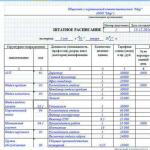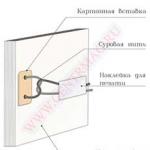The concept of the temperature range of metal pressure processing. Temperature range of brittleness. Change in the state of aggregation of a substance
For hot forming metal is heated to a certain temperature ( then "temperature" - "t-ra.") and is deformed until its temperature drops to such a level that further deformation is impossible. Thus, the metal can be deformed within a strictly defined temperature range. Maximum temperature it's called upper limit, and the minimum is the lower one. Each metal has its own strictly defined interval of hot pressure treatment.
The upper limit of the temperature interval t v.p is chosen so that there is no overburning, intense oxidation and decarbonization, as well as overheating. When choosing the upper limit of the t-range for high-carbon and alloy steels, it is necessary to keep in mind their greater tendency to overheat.
The temperature of the lower limit t n.p should be such that after deformation at this t the metal does not receive strengthening (hardening) and has the required grain size. The choice of the lower limit is of particular importance for alloy steels and alloys that do not have phase and allotropic transformations, for example, for austenitic and ferritic steels. The final properties of these steels are determined mainly by the lower limit of the temperature range (since they are not subject to heat treatment).
Practically, the upper limit of tvp for carbon steels is located 100-200° below the solidus line AE (Fig. 1.12). For hypoeutectoid carbon steels, the optimal forging end point is A 3 + (25 - 50°).
For low-carbon steels (up to 0.3% C), finishing pressure treatment in the temperature range A 3 - A 1 is quite acceptable (Fig. 1.12, dashed line). In this case, the final grain size is finer than at the end of the process above A 3 . For hypereutectoid steel, pressure treatment ends in the range t-p A st - A 1.
At the end of processing in this temperature range, the cementite released below the SE line has the form of small crushed inclusions. This improves the service properties of hypereutectoid steels, in particular, the cutting properties of the tool increase. With increasing carbon content, the ductility of steel decreases. Therefore, at relatively low temperatures close to A 1, pressure treatment of high-carbon steels can be completed only if the stress state scheme provides the metal with high ductility (for example, stamping in closed dies, etc.).
If the scheme of all-round uneven compression is expressed less sharply, as, for example, during forging on flat dies, then with an increase in the carbon content in hypereutectoid steels, the lower limit of the forging t-range should be slightly increased (Fig. 1.12, dashed line). In Fig. 1.12 the temperature interval is plotted as a shaded area. From this figure it can be seen that with increasing carbon content in steel, the temperature of the boundaries decreases and the temperature range narrows.
Unlike crystals, glasses do not have a specific solidification or melting point. Both of these processes occur in a certain temperature range. This fundamental difference in properties is explained by the structural features of crystals and glasses (Fig. 1.4).
crystal glass
Rice. 1.4. Structures of crystalline and glassy
state of matter
The energy of pair interaction of atoms in a crystal is the same: e 1 =e 2 =e 3 =¼=e i. As the temperature increases, the mobility of coordinately vibrating atoms in the correct direction increases. crystal lattice, the average distance between them increases. Due to the anharmonicity of atomic vibrations, areas of compaction and rarefaction of the crystalline structure arise. Local microvolumes of relatively closely spaced atoms appear. At melting temperature T pl Due to the disappearance of tangential stresses between atoms in rarefaction regions, slip planes of adjacent neighboring microvolumes with densely located atoms appear. Such groups of atoms have high mobility and move relatively freely in the liquid. Fluidity is the main property of a liquid.
In glass, all bonds are unequal in size and direction: e 1 ¹e 2 ¹e 3 ¹¼¹e i. As the temperature increases, the distance between atoms increases, the attractive forces gradually decrease without significantly weakening the bonds between neighboring microvolumes. First, weaker isolated connections are broken, and then strong ones. There are no crystallographic planes in glass; weak bonds are not localized in certain planes, as in a crystal, but are distributed randomly throughout the glass structure. Since the weak bonds are scattered and misoriented, distributed throughout the entire volume of the glass, when heated, there is no sudden increase in the fluidity of the substance. Due to the geometrically irregular structure of the glass, the appearance of sliding planes is excluded. An increase in temperature leads to a gradual softening of the glass structure. The glass does not melt, but softens.
When cooled, the glass-forming melt passes from a liquid state to a plastic state and only then to a solid state.
Glass transition process: melt®plastic state®solid state.
When heated, the system also goes through the stage of the plastic state.
Softening process: solid state®plastic state®melt
The temperature range in which glass transition or softening processes occur is called the glass transition temperature range. The glass transition interval is limited by two temperatures: on the high temperature side - temperature T f; on the low temperature side - temperature T g.
T f– flow point (German fliissigheit – liquid);
T g– glass transition temperature (German glas – glass);
When cooled below the glass transition temperature, glass loses its last properties of a liquid, becomes a solid and is characterized by brittle fracture. When heated above the fluidity temperature, glass loses the last properties of the solid state and glass threads can be drawn from the glass melt. It is impossible to form glass products below the fluid temperature. The glass transition and softening processes are single-phase (Table 1.1).
Table 1.1
Comparison of the properties of crystalline and
glassy bodies
Since in glasses the distances between atoms and their interaction energies for different pairs of neighboring atoms differ, the glass structure always contains a certain proportion of atoms with an interaction energy lower than in the corresponding crystal. These atoms largely determine the plastic properties of glass. Therefore, temperatures T g and T f always lie below the melting temperature T pl of the corresponding crystal and depend on the composition of the glass. Temperature T g and T f are characteristic temperatures on the temperature dependence of glass viscosity (Table 1.2).
Table 1.2
Characteristic temperatures of various glasses
Glass transition temperature T g corresponds to viscosity h = 10 12,3 Pa×s, flow temperature T f corresponds to viscosity h = 10 8 Pa×s (Fig. 1.5).

Rice. 1.5. Temperature dependence of viscosity
Let us note a very wide range of changes in viscosity in the glass transition range. Viscosity of glassy melts near the melting point T pl usually very large. Table 1.3 below compares the viscosities of various substances (1 Pa×s = 10 poise).
Table 1.3
Viscosities of melts of various substances
General terms glass formation when cooling the melt:
1. As the temperature at the melting point decreases, viscosity should increase intensively, but not abruptly.
2. The possibility of transferring a substance into a glassy state from a liquid is determined for each substance by the cooling rate in the temperature range where the probability of crystallization is high. Cooling rate in the range from the liquidus temperature to the glass transition temperature T g must exceed the critical value at which the formation of crystallization centers is possible.
The glass transition interval is widely used in the theory and practice of glass melting. However, the boundaries of the glass transition interval are arbitrary and depend on the experimental conditions.
For example, for glasses of the PbO-SiO system 2 data was obtained (Table 1.4).
Table 1.4
Change in glass transition temperature with speed
heating a glass sample
The higher the heating rate, the higher the glass transition temperature. To ensure unambiguous ideas about the properties of various glasses, characteristic temperatures are determined at a standard sample heating rate of 3 degrees/min. To determine glass transition temperatures T g and softening T w As a rule, a dilatometer is used.

Rice. 1.6. Effect of temperature on linear dimensions
glass sample
The glass transition temperature is found graphically (Fig. 1.6) by the intersection of the tangents on the dilatometric curve and is a convenient criterion for analyzing the properties of glass. In reality, glass does not have a glass transition temperature, since no properties of glass at temperature T g do not change abruptly. The glass transition temperature reflects the appearance of qualitatively new properties in glass when heated, which are absent in hard glass at low temperatures. At the glass transition temperature, the solid state begins to gradually transform into the liquid state. This process is completed at the flow temperature, but free flow is fully manifested when the viscosity of the glass melt is 10 Pa∙s or less. In the viscosity range 10 8 -10 2 Pa∙glass melt is plastic, which allows you to shape the glass different shape, easily fixed when cooled to the glass transition range.
Despite the conventionality of the concept of glass transition temperature, this characteristic temperature is widely used in the practice and theory of glassmaking. The glass transition temperature can also be determined by cooling the sample.
For example, for glass of the Na system 2 O-CaO-SiO 2 the following values were obtained (Table 1.5).
Table 1.5
Effect of cooling rate on glass transition temperature
With increasing cooling rate, the glass transition temperature T g increases. This dependence can be substantiated theoretically by analyzing cooling as a relaxation process. Relaxation is the process of transition of a system to an equilibrium state. Relaxation time is inversely proportional to the cooling rate
 .
.
On the other hand, relaxation is an activation process.
 ,
,
where U is the activation energy of the process of structural restructuring during relaxation.
Let's compare both dependencies:
 ,
,  ,
,
 .
.
On the right side of the last equation, all parameters except the cooling rate W cool, are constant. Experimental equation for T dependence g= T g(W cool) for glassy substances has similar look:
 ,
,
where C 1 – constant, depending on the composition of the glass.
The higher the melting temperature of the corresponding crystalline substance, the higher the glass transition temperature (Table 1.6).
Table 1.6
Melting and glass transition temperatures of various oxides
For many glasses, the “two-thirds” rule is followed:
 ,
,
which is confirmed by the data in the table.
Heating the metal before pressure treatment.
At certain temperatures, plastic materials have high ductility and low resistance to deformation. These temperatures have upper and lower limits, between which lies the temperature range of pressure treatment.
During cold deformation (i.e., at temperatures for pure metals usually below 0.3 absolute melting temperature), hardening (hardening) of the deformed metal occurs. In this case, the elongation of its grains in the direction of deformation is observed, a certain crystallographic orientation of the grains (texture) is created, crystallographic lattices are distorted, additional (secondary) stresses accumulate, etc. Phenomena. The strength, yield, and hardness of the metal increase, while elongation, transverse contraction, and impact strength decrease. With increasing deformation, hardening increases, further deformation becomes difficult and, finally, impossible. Then the destruction of the deformed metal occurs.
As the deformation temperature increases, processes occur in the metal that prevent hardening, namely recovery (rest) and crystallization (softening processes).
Return, the signs of which appear at temperatures usually above 0.3 absolute melting point, consist in a decrease in the distortion of the crystallographic lattice resulting from deformation and a decrease in additional stresses. However, in the presence of recovery, signs of hardening still appear, although to a lesser extent, therefore the main role in softening is played by recrystallization, the signs of which appear at temperatures usually above 0.4 melting point.
Recrystallization consists in the appearance in the deformed layer of metal of new crystallization centers and the growth around them of new grains with a new orientation of the crystallographic lattice and new boundaries between the grains. With complete recrystallization, the deformed metal has no traces of hardening.
If recrystallization does not proceed completely, then a decrease in ductility is observed. This is explained by the fact that the metal becomes inhomogeneous as a result of the presence of recrystallized and non-recrystallized grains, and often a non-single-phase state (if the temperature coincides with the temperature of phase transformations). Therefore, heating is necessary to a temperature that ensures complete recrystallization of the metal during forging or stamping. This determines the lower limit of the temperature range of hot metal forming.
The completion of the recrystallization process depends not only on temperature, but also on the rate of deformation, since recrystallization does not occur instantly. This explains the lower resistance to deformation of metal in a hot state on a press than on a hammer. With increasing temperature, plasticity increases. However, at temperatures close to the melting point, the metal melts and oxidizes along the grain boundaries, the bond between grains is broken, and the metal completely loses its ductility and strength. This phenomenon is called burnout.
Below the burnout temperature is the temperature overheating. At this temperature, a process of continuous grain growth (collective crystallization) occurs in the metal. This temperature can be called critical. At the same time, during pressure treatment the grains are destroyed. Therefore, for a number of metals, for example, for most steels, coarse grain size is not an obstacle when forging and stamping. Thus, the upper range of hot pressure treatment is either below the overheating temperature or below the burnout temperature, within the overheating temperature (depending on the type and properties of the metal).
The temperatures at the beginning and end of pressure treatment for alloys with a base fluctuate sharply depending on the content of other components in them. For example, for various wrought aluminum alloys, the upper limit is between 470 - 500˚C, the lower - between 350 - 400˚C; for copper alloys, the upper limit is between 700 - 900˚С, the lower limit is between 550 - 800˚С; for magnesium alloys, the upper temperature is 370 - 430˚С, the lower temperature is 300 - 350˚С; for titanium alloys, the upper one is 1000 - 1200˚С, the lower one is 700 - 950˚С; for steel, the upper one is 1100 - 1300˚С, the lower one is 800 - 950˚С.
If we mark on the diagram the state of the iron-carbon alloy and the temperature range of pressure treatment of carbon steels, then its upper limit will be located on the curve passing 150 - 200˚C below the solidus line. The lower limit of the temperature range for carbon steels corresponds to approximately 800˚C, i.e. approximately 75°C above the PSK line. Thus, steel containing from 0.4% to 1% C from the beginning to the end of pressure treatment is in a single-phase state (austenite). Carbon steel with a lower carbon content is finished processing in the presence of two phases: austenite and ferrite. This results in some hardening, which is easily removed by subsequent heat treatment.
Carbon steel containing more than 1% C is also finished when it contains two phases: austenite and secondary cementite. But in this case, pressure treatment, crushing the cementite network, has a beneficial effect on the structure of the steel. The temperature range for forging and stamping of non-ferrous metals and alloys is determined from the plasticity diagram, flow curves, deformation resistance diagrams, state diagrams and recrystallization diagrams.
HEATING WHEN PRESSURE TREATING METALS
Metals and alloys are heated before pressure treatment about a certain temperatureto increase their ductility and reduce resistance to deformation.
This temperature is called start temperature of hot pressure treatment.
However, during processing the temperature of the metal decreases. The minimum temperature at which processing can be carried out is called end temperature of pressure treatment.
The temperature range between the beginning and end of processing, in which the metal or alloy has the best ductility, the least tendency to grain growth and minimum resistance to deformation, is called temperature range of hot pressure treatment.
Distinguish
optimal(valid)
And technologically necessary temperature ranges for forging, stamping.
Optimal the interval is determined by the difference in temperatures between the beginning and end of forging, but these temperatures can be accurately determined only on the basis of specific data relating to the metal (from metallurgical, metallurgical and operational points of view). Therefore, approximate temperatures are usually indicated, which are then refined. Main factor, which determines these temperatures, - chemical composition alloy and the properties it determines.
The temperature range of pressure treatment is selected taking into account the state diagram of the alloys. Steel should be deformed in a certain temperature range, located on the diagram above point A and below the melting temperature. In general, the start temperature of processing is taken to be
150...200°C below the solidus line, and the end of processing - 25...50°C above point A3 (for hypoeutectoid steels) or point A 1 (for hypereutectoid steels).
It is clear from the iron-carbon diagram (Fig. 22.1) that with an increase in the amount of carbon in the steel, the temperature range of treatment narrows (shaded area). In this case, the temperature at the start of processing decreases especially sharply.
When metals and alloys are heated above the start temperature of hot working, intensive growth of austenite grains begins.
Structure becomes coarse-grained, and it happens decrease in its plastic properties. This phenomenon is called overheating. It is considered a defect, which in most cases can be eliminated by annealing or normalization. However, for some steels (for example, chromium-nickel), the correction of overheated metal is associated with significant difficulties and simple annealing is insufficient.
With a further increase in heating temperature melting of the fusible constituent grains occurs located along the borders. In addition, oxidation of grain boundaries by oxygen contained in the working space of the furnace leads to the formation of brittle oxide film and causes a phenomenon called burnout and accompanied by a complete loss of plasticity. Burnout- irreparable marriage.
Heating workpieces to high temperatures is accompanied by other harmful phenomena. The metal of the heated workpiece, in contact and chemically interacting with furnace gases containing oxygen (water vapor and carbon dioxide), oxidizes and decarbonizes. In this case, a scale, consisting of iron oxides. Frenzy metal when heated in fiery furnaces reaches 3%.
In addition to furnace gases, the amount of scale formed is influenced by
heating temperature,
chemical composition of the workpiece metal and
the ratio of its surface to volume.
For example, at 1300 °C the oxidation rate of a steel billet is seven times higher than at 850...900 °C. As the ratio of the workpiece surface to its volume increases, the amount of scale increases. As the carbon content in steel increases, the amount of scale decreases when heated. Reduce scaling and some chemical elements - aluminum, chromium, silicon.
Scale has greater hardness than heated metal, therefore tool wear increases almost twice. Scale degrades surface quality; its thickness reaches 1.5...2 mm, which forces the allowances for subsequent machining to be increased. Simultaneously with scaling, decarburization of the metal occurs - burning of carbon from the surface of the workpiece. Decarburized metal layer must be completely removed during cutting.
Sometimes technologists lower the upper limit of the forging temperature range due to the need to reduce excessive scaling or decarbonization metal This reduction is more significant for large workpieces, since heating them requires big time aging in the oven.
At forging cast metal (ingots)) forging start temperature can be slightly increased.
Application accelerated heating mode also allows you to increase upper limit of temperature range, but in all cases the metal must withstand the specified technological process deformation without cracking. If small deformations are required at the beginning of forging, they can be carried out at temperatures higher than when forging with large deformations.
Lower limit of forging temperatures, stampings are more difficult to specify. Here it is necessary to take into account not only the composition of the steel (hypereutectoid or hypoeutectoid), but also the volume of the forging, the quality of the required metal, the presence or absence of heat treatment of the forging, the method of cooling (including using forging heat for heat treatment, etc.).
When setting forging temperatures, it is important to take into account the requirements for the mechanical properties of the metal, taking into account the nature of the operation of the part.
If heat treatment is provided for a given part, for example, quenching and tempering, then the correctly selected temperature of the end of forging, stamping (above point A r 3 for medium-carbon steel) allows forging heat to be used for subsequent heat treatment. If heat treatment is not provided, then the lower limit of the forging temperature range is limited by the conditions for obtaining fine grains. For small forgings (weighing up to 1000 kg), the temperature at the end of forging and stamping can be high (200...300 °C above point A r 3) or low (near this point). Despite the fact that at a high temperature at the end of forging or stamping the grain will be large, as a result of rapid cooling it is possible to obtain a fine structure of the alloy structure and the corresponding mechanical properties. The high temperature at the end of processing helps to improve the technical and economic indicators of production (increased productivity, reduced energy consumption). It is necessary to select a ratio of temperature and final deformations that would ensure the optimal structure. It should be borne in mind that steel subjected to deformation in the range of critical deformation values (4...10%) will have an undesirable coarse-grained structure after recrystallization.
It is desirable that the metal be in a single-phase state in the temperature range of pressure treatment. In a two- or multiphase state, with low plasticity of one of the phases, destruction of the metal is possible. An exception is hypoeutectoid steels, which at temperatures of the two-phase state between the GS and PS lines (see Fig. 22.1) have sufficient ductility. This plasticity is also characteristic of hypereutectoid steels at temperatures above 750 °C, at which a two-phase structure of austenite + secondary cementite is fixed between the ES and SK lines. Cementite is located in the form of a network along the grain boundaries and reduces the ductility of steel. However, after the destruction of this network by pressure treatment, the plasticity of the steel is restored.
Forging and stamping of medium-carbon steel ends above point A r 3, which ensures a stable fine-grained structure of the steel. For low-carbon steel (up to 0.3% C), a lower temperature region at the end of forging and stamping is permissible (in the interval between points A r 3 and A r 1), especially for large forgings. In this case, the final grain size is less than when forging is completed at a temperature above point A r 3. For hypereutectoid steel, in which the structural free phase is brittle cementite, the temperature at the end of forging, stamping should be as low as possible, and cooling of the forgings should be rapid during avoiding the formation of a cementite network at high temperatures at the end of processing. To destroy the cementite mesh, forging and stamping should be completed in the temperature range of the critical points A rm -A ri. In this case, before annealing steel onto granular pearlite, there is no need to carry out normalization, and forging heat can be used for annealing. The end of forging and stamping of hypereutectoid steel as close as possible to point A r 1 is unacceptable for steel with a high carbon content, in which, due to graphitization, a defect such as a “black fracture” can form.
In shop conditions, the range of forging temperatures is sometimes specified based on subjective reasons. The end of the stamping is adjusted based on the tool life. Heated dies quickly “shrink” when stamping a cooling workpiece due to a significant increase in deformation resistance. Sometimes an increase in stamping temperature is caused by insufficient power of the equipment used.
As can be seen from the graph in Figure 22.1, the maximum forging temperature range for low-carbon steel is -500 °C, for eutectoid steel - 400...450 °C, hypereutectoid - 200...300 °C. For high-alloy steel this temperature range is even smaller. For example, for heat-resistant steel it is 100... 150 °C.
The forging temperature range is usually clarified during the following laboratory studies:
determine the ductility of steel during upsetting until the first crack appears within the approximate range of forging temperatures;
build a change curve impact strength in the same temperature range;
determine deformation resistance at temperatures of the approximate end of forging, stamping;
are building recrystallization graph metal after processing with varying degrees of deformation.
In fact, the used forging temperature range can exactly coincide with the optimal range only in a particular case when the time tK spent on forging, stamping, and the steel cooling time t0 in the forging temperature range under given processing conditions are equal. Both of these values can vary significantly depending on the complexity of the forging and the pace of work, depending on the degree of mechanization of the process and the speed of the equipment. If tK< t 0 , что часто встречается при штамповке, то допустимый интервал температур не используется и технологу следует решить вопрос, за счет какой из температур сократить этот интервал. Высокий нагрев металла без достаточной его проковки не обеспечивает необходимого качества металла даже за счет регулирования скорости охлаждения, поэтому в подобных случаях, чтобы избежать дополнительной термической обработки, приходится сокращать интервал температур за счет снижения верхнего порога температуры процесса. Если t K >t 0 , then forging is carried out in two or more steps.
Temperature ranges for forging and stamping of various alloy steels and alloys are indicated in specialized literature and reference books.
Plasticity called the ability of metal deform without destruction under load .
At tensile test Plasticity is determined by two quantities: relative elongation and relative narrowing.
In order to understand how these values are determined, the sample should be compared with the destroyed sample before testing, as is done in Fig. 22 (above). After destruction, the sample turned out to be longer, but it narrowed, especially at the necking site.
Relative extension determines by what amount the sample has elongated after stretching in relation to the original length.
This value is denoted by the letter δ (delta) and is expressed as a percentage:
· l 0- initial estimated length of the sample in mm;
· l- final value of the estimated length in mm.
The tensile strength is defined as
Relative narrowing characterizes the degree of reduction in the cross-sectional area in the neck.
This value is designated by the letter φ (psi) and is expressed as a percentage:
· F 0- initial area in mm 2;
· F-- area in the neck in mm 2.
Usually mechanical characteristics of metal at high temperatures reaching the melting point, determined on special installations, including a heating device that simulates the welding temperature cycle, and a mechanical part and equipped with recording devices.
The sample to be tested is heated to the temperature at which it is necessary to determine its properties, and loaded, recording the curves П = f(T).
In Fig. Figure 12.39 shows typical curves characterizing the change in strength and ductility of alloys at high temperatures. In the region of heating to temperatures close to the equilibrium solidus temperature (Tc), the strength and ductility of the alloys drop sharply.
Plasticity remains at a very low level in a certain temperature range, and then increases again.
Such an ambiguous change in properties can be explained by considering the process of crystallization of a metal from a liquid state.
After melting, the metal under study is cooled and, starting at a temperature T, nuclei of the solid phase are formed in it. As long as the amount of the solid phase is small, the metal is in a liquid-solid state, the plasticity of the melt is practically no different from the plasticity of the liquid, since the crystals of the solid phase move freely in the liquid, without limiting its ability to flow and take any shape (Fig. 12.40 , A). Metal is able to take on a new shape under load without collapsing.
Starting from a certain temperature, called the temperature of the upper limit of the brittleness interval (T VG), the metal passes into the stage of a solid-liquid state, characterized by such an increase in the amount of the solid phase, in which the ability of liquid to flow between solidified grains sharply decreases.
During deformation, grains jam, and further process becomes possible only in the case of plastic deformation of the grains themselves or their displacement relative to each other.
However, the strength of the crystallized solid phase during this period is much greater and therefore, if destruction occurs, it occurs along the grain boundaries, i.e., it is intercrystalline in nature.
The plasticity of a metal at this stage of solidification is very small - a fraction of a percent. The metal is capable of taking on a new shape under load with destruction along the grain boundaries, including eutectics, the strength of which is lower than the strength of the hardened grains.
With a further decrease in temperature, the strength of the interlayers increases, their volume decreases, and the number of contacts between grains increases.
At the same time, the strength of the grain boundaries themselves increases. At a certain temperature, the boundaries become so hardened that destruction begins to occur not along them, but along the body of the grains themselves (point A).
In this case, the plastic properties of the material increase, since the deformation is no longer concentrated in small layers between the grains, but is perceived by the entire aggregate quite uniformly.





